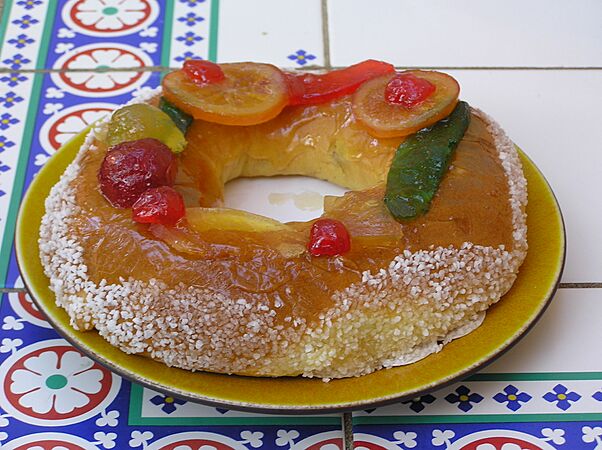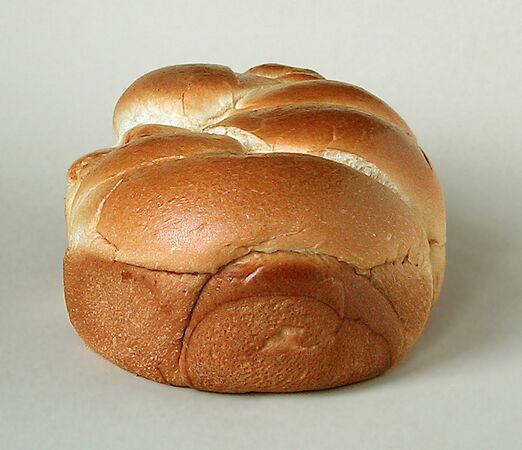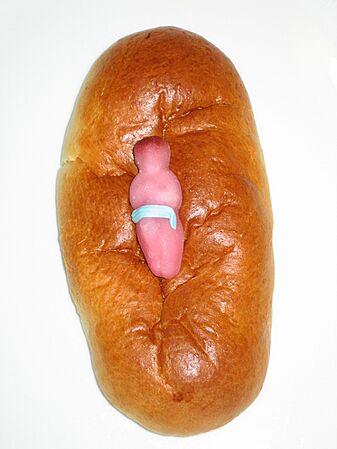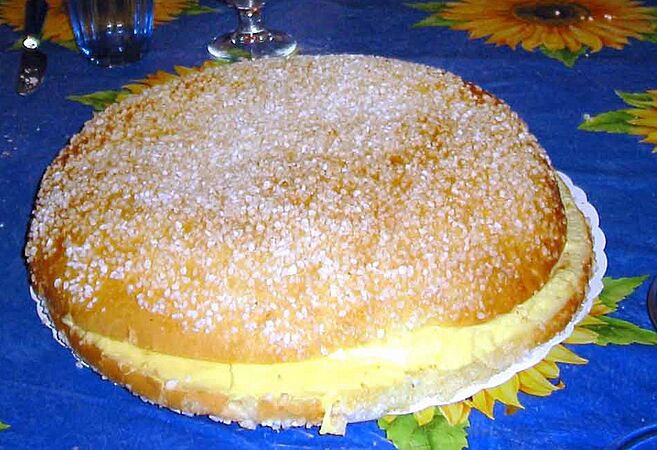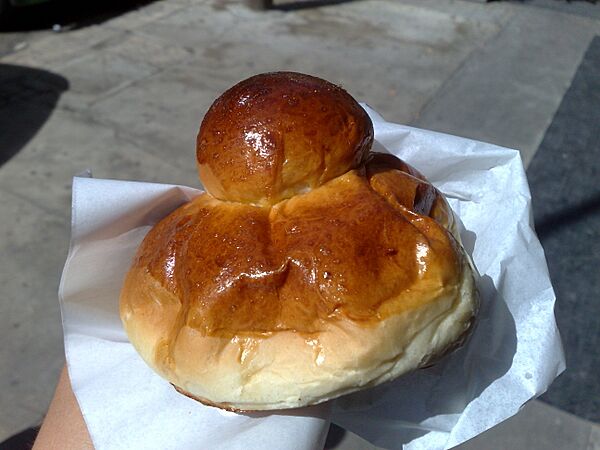Brioche facts for kids
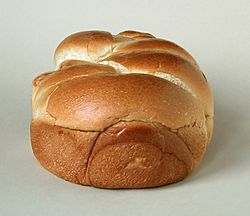 |
|
| Type | Bread or pastry |
|---|---|
| Course | Breakfast, dessert, or snack |
| Place of origin | France |
| Main ingredients | Flour, eggs, butter, milk, water, cream |
Brioche (say "bree-OSH") is a special kind of bread from France. It's different from regular bread because it has lots of eggs and butter in it. This makes it super rich, soft, and tender.
A famous chef named Joël Robuchon once said brioche is "light and slightly puffy." It has a lovely dark, golden, and flaky crust. Bakers often brush it with an egg wash before baking to make it extra shiny and golden.
Brioche is like a mix between bread and a pastry. It's made like bread but tastes richer because of the extra ingredients. These include eggs, butter, milk, water, cream, and sometimes even a little sugar or brandy. Brioche is often eaten for breakfast or as a snack. You might find it with fruit or chocolate chips inside. It's also a great base for many different desserts!
Contents
What Kinds of Brioche Are There?
Brioche is super versatile and can be used in many ways. You can eat it plain, or fill it with yummy things.
- Savory Brioche: Sometimes, brioche is filled with savory ingredients. Imagine it with beef, foie gras, or sausage!
- Sweet Brioche: It's also delicious with sweet fillings. Fresh fruits, vanilla cream, or jam are popular choices.
Classic Brioche Shapes
There are a few classic ways brioche is shaped:
- Brioche à tête: This is probably the most famous shape. It looks like a round loaf with a smaller ball of dough on top, like a "head" (tête in French). It's baked in a special fluted pan.
- Brioche de Nanterre: This one is baked in a regular loaf pan. Instead of one big piece, small balls of dough are placed in rows. As they bake, they rise and join together, making a pretty pattern.
You can also bake brioche dough in a pan without shaping it into balls, making a simple loaf.
How Is Brioche Made?
Brioche dough is made from flour, eggs, butter, and a liquid like milk or water. It also needs yeast (or sourdough) to help it rise, salt, and sometimes sugar. A common recipe uses about twice as much flour as butter. That's a lot of butter!
The Baking Process
Making brioche usually involves these steps:
- First, the dough is mixed and allowed to rise at room temperature until it doubles in size. This is called "proofing."
- Then, the dough is gently pressed down and put in the refrigerator. This slows down the rising process and helps the flavors develop. It also makes the dough firmer and easier to shape.
- Next, the dough is shaped and placed into baking pans for a final rise.
- Before baking, it's often brushed with an egg wash to give it a golden crust.
- Finally, it's baked at about 230°C (450°F) until the crust turns golden brown and the inside is fully cooked. Small brioche rolls might take 1 to 1.5 hours to rise, while larger loaves take longer.
The History of Brioche
The word "brioche" first appeared in French writings in 1404. In 1611, an English dictionary described it as "a roll, or bun, of spiced bread" and said it came from the Normandy region of France.
Brioche slowly developed from a type of "blessed bread" used in churches. Over time, bakers and pastry makers started adding butter, eggs, and later sugar, making it richer and more delicious. In the 17th century, different versions of brioche existed, some with less butter for everyday use, and others much richer for special occasions.
By the 18th century, brioche became very popular, especially in areas known for their butter, like Gisors and Gournay. Wealthy people, especially from the time of King Louis XIV, loved brioche made with lots of butter.
There's a famous saying, "Let them eat cake" (or "Qu'ils mangent de la brioche" in French). This quote is often wrongly linked to Queen Marie Antoinette. However, it was actually written by Jean-Jacques Rousseau in his autobiography, Confessions, where he said "a great princess" advised it when peasants had no bread.
What Does "Brioche" Mean?
The word "brioche" comes from an old French word, "brier." This was a Norman (from Normandy) way of saying "broyer," which means "to work the dough." It refers to using a special wooden roller to knead the dough. The ending "-oche" is a common French suffix. So, brioche is basically "dough that has been worked."
Other Types of Brioche and Similar Breads
- La brioche aux fruits confits or gâteau des rois (King's cake)
- Gâche
- Brioche de Nanterre
- Brioche vendéenne
- Brioche tressée de Metz (Braided brioche from Metz)
- Cougnou
- Pogne, from Dauphiné
- Gâteau de Saint-Genix, from Saint-Genix-sur-Guiers
- Chinois or Schneckenkuchen ("snail pie"), from Alsace-Lorraine
- Tarte Tropézienne, a brioche tart with custard
- Brioscia, from Sicily
- King cake
Many other breads around the world are also made rich with eggs, milk, and butter. Many of these are also braided, just like some brioche types!
Gallery
-
A huge 15 kg brioche used in a traditional dance in Vendée
See also
 In Spanish: Brioche para niños
In Spanish: Brioche para niños



